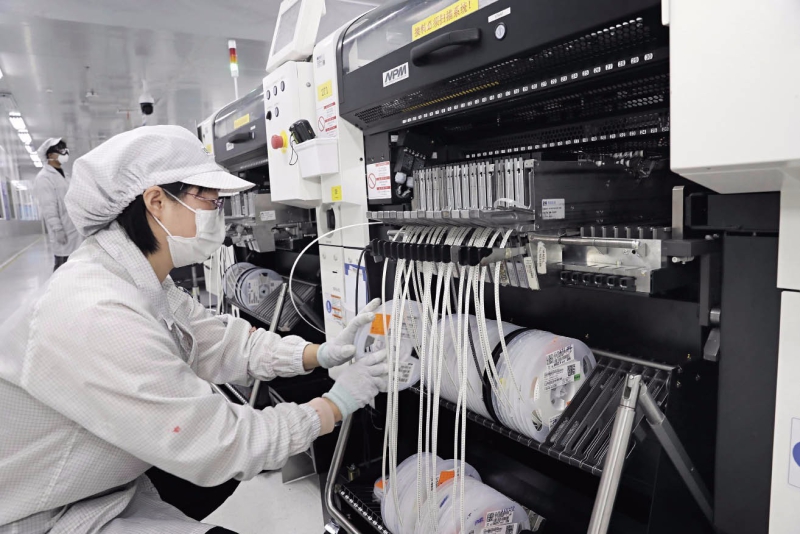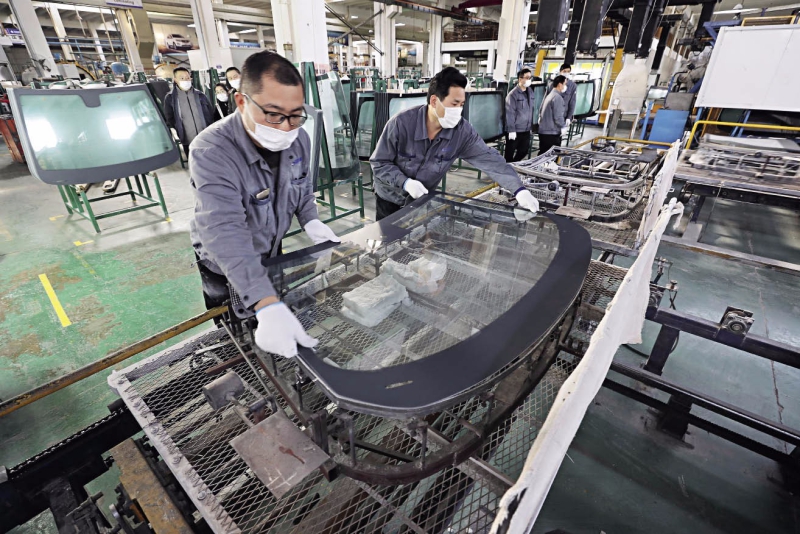___________
ZHANG XIN is an associate researcher at the Research Department of Innovation Development with the Development Research Center of the State Council.

On February 10, 2020, a number of key enterprises in Chongchuan and Gangzha districts, Nantong City, Jiangsu Province resume work.
SMEs Needing Help
SMEs, which account for 99 percent of total enterprises in China, are a significant segment of China’s economy. They contribute about 60 percent of the national GDP, 50 percent of tax revenue, 75 percent of technological innovation, and 80 percent of new products. However, SMEs, being especially prone to risks, were hit the hardest during the epidemic.
According to a survey conducted jointly by Tsinghua University and Peking University in mid-February, more than half of the 995 SMEs interviewed saw their operating income drop by more than 20 percent, while most of them face a cash crunch.
For a while, a string of negative events dominated the business world. IT training organization XDL declared bankruptcy. Popular bricks-and-mortar karaoke club King of Party in Beijing laid employees off and teetered on the brink of insolvency. The Chengdu-based elevator digital advertising service provider XinChao Media Group announced that it would cut 500 workers to survive the coronavirus the day it resumed operation after the Spring Festival holiday. Sa Sa International Holdings Limited, a leading cosmetics retailing group in Asia, contemplated cutting 3 percent of its staff. The Chinese catering chain brand Xibei was also handicapped by cash flow constraints and is in urgent need of help.
To help the SMEs cushion the blow of the epidemic, the State Council has issued a raft of fiscal, tax, financial, and other policies since early February. As the epidemic gradually subsides, the government has intensified moves to unfold relevant polices in a much more concentrated manner.
According to the Ministry of Industry and Information Technology (MIIT), central government departments have implemented up to 142 policy documents as of March 5 to prop up SMEs against the economic fallout of the epidemic. In addition, the number of relevant support policies rolled out by local governments far exceeds this figure. The municipal government of Yancheng in east China’s Jiangsu Province contacted 10,000 SMEs to help them address the challenges in raw material supply, labor recruitment, operation resumption, financing, and product export.
These policies included those reducing operating cost of enterprises, assisting workers to return to factories, subsidizing and reducing the property rent paid by SMEs, and subsidizing SMEs organizing online or offline training programs for their employees during the shutdown period. SMEs have received much needed support to help them overcome difficulties and resume production.
Policy Backups
Targeted financial backing has been allocated to a large number of SMEs.
A State Council meeting held on February 18 decided companies would be exempted from social security contributions to mitigate the impact of the epidemic on enterprises, especially on SMEs. The MIIT also rolled out measures to ensure the implementation of national fiscal and tax support for key enterprises, encouraged local governments to introduce relevant fiscal support policies, and pledged to increase government procurement.
The policies proved effective. In Shanghai, it means reducing the burden of SMEs by more than RMB 12.7 billion (US $1.83 billion). In Beijing, catering firms seriously affected by the epidemic could finally catch their breath when they are allowed to postpone contributions to employees’ social security to the end of July. The amount of contributions is estimated to reach RMB 320 million (US $46.15 million).
Take the Chinese catering chain brand Xibei as an example. Its outlets in Beijing pay an average of RMB 2.47 million (US $356,339) every month in social security contributions for its employees. Its cash flow began drying up due to its normal operation being interrupted by the virus. With the policy allowing it to delay social security contributions, it could have a chance to survive this difficult time.

On March 4, 2020, workers of Jiangsu Tiemao Glass Co., Ltd. are busy in the production workshops. After resuming production, the production and goods delivery work of the enterprise are carried out in a tight and orderly manner.
Financial Support to Tide Over the Plight
The State Council meeting on February 25 pledged to strengthen credit aid for SMEs. Lenders were encouraged to roll over loans to cash-strained SMEs, micro companies, and individual businesses until June 30 and waive their default interest payments. The central bank pledged to issue RMB 500 billion (US $71.2 billion) re-lending and re-discount quotas to back up small and medium-sized banks in their credit support for SMEs and micro companies.
The MIIT also called for efforts to lower interest rates of loans for SMEs, strengthen financing guarantee services, introduce new financing products and services, and advance equity investments.
To sustain the stable progress of SMEs, Shandong Province has vigorously trimmed the cost of credit financing and ensured that small and micro enterprises get loans at a lower cost than last year. The comprehensive financing cost of inclusive loans for small and micro enterprises is 0.5 percentage points lower than that of last year.
Many places introduced discount government loans and promised compensation for loan risks to key enterprises supporting the national efforts to combat the coronavirus. In Guiyang Economic Development Zone in southwest China’s Guizhou Province, the government has earmarked RMB 28.57 million (US $4.12 million) as financial support to SMEs.
Guizhou Haiyue Mold Co., Ltd., a protective goggles mold maker, was the first company to get the government support totaling RMB 10 million (US $1.44 million) in the form of equity investment. The company spent only eight days in developing the mold for protective goggles and made stellar contribution to increasing medical supplies for the epidemic control in the province.
A substantial RMB 18.5 million (US $2.67 million) in working capital loans has been paid to seven enterprises. The Guizhou Zhuoyue Hospital Property Service Co., Ltd. received more than RMB 40,000 (US $5,765) as subsidy to the interest rate of its bank loan. Since the outbreak of the epidemic, the enterprise has been shipping medical supplies to hospitals.
Since the beginning of the year, the Industrial Bank Co., Ltd. has granted loans the amount of RMB 2.44 billion (US $352 million) to 135 SMEs contributing to epidemic prevention and control. The bank, meanwhile, has rolled over and renewed loans for promising businesses affected by the epidemic in sectors like wholesale, retail, catering, logistics, transportation, and cultural tourism.
New Technology Driving Economic Recovery
Innovative technology, under the assistance and encouragement of government, is sparking enterprises to solve the problems associated with production resumption and business operation.
Platforms integrating blockchain with financial services have been put into use, which will effectively reduce the financing threshold and cost for SMEs.
Such a platform was launched in February in Beijing. The system confirms receivables under government procurement contracts by means of blockchain technology. It also integrates various financial services including financing guarantees and asset management so as to provide comprehensive financial services throughout the supply chain for SMEs.
A number of science and technology companies, supported by the government, also began to utilize blockchain technology to provide financial support for SMEs. The e-commerce platform launched by the State Grid Corporation of China turns business records on the industrial chain of power generation and supply into credit and has provided loans at preferential interest rates, reaching RMB 19.49 million (US $2.8 million) for five SMEs and micro enterprises that manufacture medical supplies for combatting the epidemic.
The government also encourages SMEs whose offline business has been greatly affected by the epidemic to do marketing online. An auto dealer in Zouping, Shandong Province, leveraged tiktok live streaming and launched online vehicle services for inspection, selection, and reservation of cars. The number of customers who visited the store prior to the epidemic was less than 100. Now, the dealer makes two online marketing sessions on tiktok every day, each garnering more than 10,000 viewers. The sales as a result have been greatly boosted.
Platforms and start-ups engaged in R&D and commercialization of the new-generation information technology, such as artificial intelligence (AI), have gained more development opportunities. To stem the spread of the virus, it is necessary to screen population groups and increase public knowledge of virus prevention. Technologies provide effective help in this regard, pushing governments to increase procurement of high-tech products.
IntelliFusion and other domestic AI start-ups have developed systems for instant body temperature checking and identity recognition, reducing the risk of virus transmission caused by long lines at check points. An intelligent voice system is also used in communities to screen patients and answer public questions during epidemic control.
President Xi Jinping ordered more targeted fiscal and taxation measures to help SMEs and micro businesses to weather the epidemic. As of March 2, nearly 50 percent of SMEs across China had resumed production, according to statistics by the MIIT. With differentiated measures for epidemic control implemented nationwide, more businesses are expected to follow suit. When the virus is tamed, suppressed consumer demands are very likely to be unleashed, giving robust boost to SMEs and pushing them back on track.
___________
ZHANG XIN is an associate researcher at the Research Department of Innovation Development with the Development Research Center of the State Council.